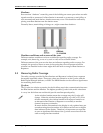
KIRK Wireless Server 1500 Installation and Maintenance
3.7 KIRK Radio Hardware
KIRK Base Stations
KIRK Base Stations are compact devices that contain
RF circuitry and transmit/receive antennas. The main
function of the Base Station is to provide audio and
data communication between the handsets and the
KWS1500. The KIRK Base Station controls the traffic
channels in the air and works as a link between the
handsets and the KWS1500.
The KWS1500 operates the Base Stations through a
wired standard twisted pair of cables. Only one pair is
required per KIRK Base Station and, by using recommended Cat 5 cabling, Base Stations
may be placed up to 2.5 km / 9,000 feet from the KWS1500 main cabinet. A Base Station
does not require an external AC power source. Instead, the Base Station is directly
powered through the cabling from the KWS1500. .
Base Stations are designed with two internal antennas and support antenna diversity.
The Base Station is also able to carry out handoff between the RF channels under the
same Base Station, and supports up to four simultaneous speech channels.
Base Stations are omni-directional and provide a radio coverage radius of around 47
meters / 150 feet indoors, or 106 meters / 350 feet outdoors in direct line-of-sight
conditions.
It is not possible to define a more exact size of a KIRK Base Station coverage area, as it
largely depends on location specifics such as building materials, etc. Before a KIRK
Wireless Solution is installed, a careful site survey should be performed in order to
accurately define how many Base Stations are required to provide the necessary coverage
at each individual site. Site surveys are also used to locate the optimal locations for each
Base Station and, if needed, locations for KIRK Repeaters.
It is possible to connect 16 Base Stations to a single KWS1500. Base Stations 0 to 7 are
supported by the KWS1500 motherboard. Base Stations 8 to 15 are supported by the
KIRK Expansion Board 1500.
By linking two KWS1500 units together using the KIRK Link Card, 32 Base Stations can
be connected.
Each Base Station supports four simultaneous conversations. In cases where more than
four simultaneous conversations are commonly required, multiple Base Stations may be
placed to create “hot spot” zones to provide high traffic capacity areas.
Base Stations are also termed Radio Fixed Part (RFP).
All Base Stations should be cabled using 24-gauge, Cat 5, twisted-pair cable. Terminate
the Base Station end of the twisted-pair cable with an RJ-11 connector on the center pair.
Base Stations are not polarity sensitive.
It is important that Base Stations are installed where the coverage is required. Therefore,
Base Stations can be installed either indoors or outdoors.
• Indoors, the Base Stations must be mounted in a vertical orientation to a
suitable, non-metallic, flat surface such as a wall or post.
72160400_issue_B 20


















